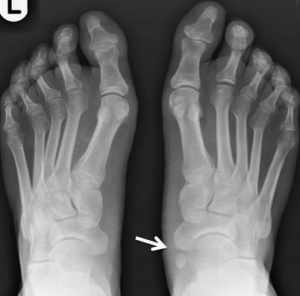An accessory navicular is a small extra bone found next to the navicular on the inside border of your foot, just up from (proximal to) the ankle. It’s the most common accessory bone in the foot, occurring in up to 5-10% of people. It is incorporated into the posterior tibial tendon which passes down the inside of the foot. Accessory navicular syndrome describes a condition in which the accessory bone or posterior tibial tendon becomes irritated and produces painful symptoms.
While the exact reason for the development of the accessory navicular bone itself is unknown, there is thought to be a genetic factor involved for some people. Accessory navicular syndrome is caused by irritation or damage to the area of the navicular and the surrounding soft tissues. This may occur from:
 What
are the symptoms?
What
are the symptoms?
Some people with an accessory navicular will remain asymptomatic throughout their lifetime and may never even know they have an accessory navicular. For others, painful symptoms can develop. Symptoms may begin during growth spurts and periods of bone maturity between the ages of 8 – 16 years, or may not begin until adulthood. Symptoms may include:
Treatment begins with relieving the painful symptoms through the resting and icing the foot. Following this, the focus is on relieving strain and pressure away from the area of the navicular to reduce the likelihood of irritation and the symptoms coming back. This may involve:
For those that don’t respond to conservative management and have ongoing painful symptoms, surgery may be indicated.

We’ve all had those days — you come home after hours on your feet, kick off your shoes, and notice your ankles look puffier than usual.
Swelling in the feet, ankles, or legs (known medically as edema) isn’t always a reason to panic. It can be as simple as a
salty lunch or a long flight.
But what if it’s happening more often — or seems to be getting worse? Swelling can sometimes be a sign of something more serious. Here’s
what could be going on and when to check in with your doctor.
.jpg)
Every year on October 8th, the world celebrates International Podiatry Day - a day dedicated to
raising awareness about foot health and the vital role that podiatrists play in our overall well-being.
Keeping your family on their feet and helping them to walk, run, play and exceed their goals is why we love getting up in the morning.
Ground Floor, One Health Building
122 Remuera Rd, Remuera
Auckland 1050, New Zealand
| MON - FRI | 7:30am – 6:30pm |
| SAT | 8:30am – 4:30pm |
| SUN | Some availability |
Make an Appointment
Online Schedule
Our virtual receptionist is available 24/7 to help with general questions, booking requests, and clinic information, even when our team is busy, or it's after hours.
Whether you're calling us or using our website, you'll get fast assistance any time of day. And if your query needs a personal touch, a member of our team will follow up as soon as possible.
If you’d like to see a podiatrist who speaks your preferred language, just give us a call and we’ll help you book.